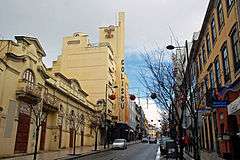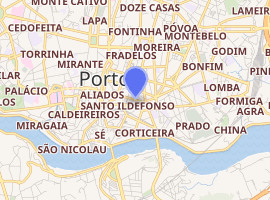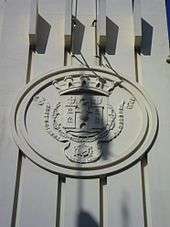Coliseu do Porto
The Coliseum of Porto (Portuguese: Coliseu do Porto) is a Portuguese theatre and concert venue in the municipality of Porto, in northern Portugal, with a capacity for a standing audience of 4000[1]. A leading venue for music and cultural events in Porto, together with Batalha Cinema, the Coliseu is an example of Portuguese Streamline Moderne and Art Deco styles in the city of Porto.
| Coliseum of Porto | |
|---|---|
Coliseu do Porto | |
 | |

| |
| Alternative names | Coliseu Porto Ageas |
| General information | |
| Type | Theater |
| Architectural style | Streamline Moderne |
| Location | Cedofeita, Santo Ildefonso, Sé, Miragaia, São Nicolau e Vitória |
| Address | = |
| Town or city | Porto |
| Country | |
| Coordinates | 41°8′48.4″N 8°36′19.84″W |
| Opened | 17 March 1908 |
| Owner | Câmara Municipal do Porto |
| Technical details | |
| Material | Reinforced concrete |
| Design and construction | |
| Architect | Cassiano Branco |
| Other information | |
| Seating capacity | 3000 |
| Website | |
| www | |
History


On 17 March 1908, the Garden-hall Passos Manuel was inaugurated. Architect Mário de Abreu designed the interior and made alterations to the principal hall, staircase and the tower facade, which was covered in windows, and removed the original neon green, red and white that accompanied the original structure at the time of its opening.[2] The Garden-hall Passos Manuel was the first local public hall in the city and "was the point of encounter for Portuense society, an elegant local, with sophisticated decorations, with ample gardens and luminous fountains that proportioned all types of entertainment. It had the capacity for 700 people (Coliseu do Porto, 60 anos)".[2]
In 1911, the hall was renovated, which included a garden and esplanade, party hall, pavilion restaurant, hall and small theatre.[2]
By 1937, though, there were already rumblings that demand exceeded the capacity of the structure; the first plans to construct a grand, modern events hall were developed by architect José Porto.[2] In 1938, the Garden-hall Passos Manuel was deactivated and demolished. The following year, Cassiano Branco assumed the position of principal architect for a new project, with the assistance of Júlio de Brito.[2] The construction of the coliseum was a troubled process, that risked the careers of various architects, such as José Porto (who abandoned the project), such as Dutch architect, Yan Wills (who made designs for the theatre) and Júlio de Brito (whose projects were rejected by the Porto Comissão de Estática).[2] But, since he was connect to the Companhia de Seguros Garantia, proprietor of the Garden-hall Passos Manuel (later the Coliseu), Brito continued to be connected with the project.[2] Charles Ciclis, who authored various projects in Parisian theatres, was invited by Cassiano Branco to work on the Coliseum project.[2] Of his interior designs, apparently only the candelabras and doors, were included in the designs, although the designer was never remunerated. The new building opened on 19 December 1941.[2]
With changing tastes and advent of popular cinema, the old concert hall was transformed into a cinema/studio in 1971.[2]
By 1981, there was a proposal to classify the building, during the 2nd Congress of the Association of Portuguese Architects.[2] But, the first initiatives were open on 11 December 1987, by the IPPC, supported by the 18 December dispatch by the Vice-President.[2]
In 1995, the Empresa Artística, SA/Grupo Aliança-UAP, sold the coliseum to IURD, the Brazilian Universal Church of the Kingdom of God (on 5 October).[2] This news boosted an unprecedented movement of indignation and revolt on the part of the Portuenses.[2] Various artist and institutions such as the municipal council, civil governor and public, reacted unanimously against the announced end of the coliseum.[2] This move resulted in the establishment of the Associação "Amigos do Coliseu do Porto", who helped stop its sale and protect the building.[2] On 28 September 1996, a public deed for the purchase of the coliseum by the municipal council, which included the cinema Passos Manuel, the Garden-hall, attic hall and a lithography for 680,000 contos.[2] During an event, a fire started in the coliseum that completely destroyed the stage, principal hall and dressing rooms.[2] The recuperated building was reopened on 17 December 1996.[2]
On 10 September 1998, the Vice-President of IPPAR at the time, re-confirmed the IPPAR's 1987 intent to classify the building.[2] This process had advanced little in the intermittent years, so that by 12 September 2005, there was a proposal by the DRPorto to classify the building as an Imóvel de Interesse Público (Property of Public Interest).[2] This was later included in the far larger special protection zone that included the buildings of the public works department, Chapel of Almas, Café Majestic, Church of Saint Ildefonso and Cinema Batalha, which was later approved by the consultive council of IGESPAR (12 November), and supported on 29 September 2010, by the National Council of Culture.[2] The Secretary of State for Culture ratified its classification as a Property of Public Interest.[2]
In September 2015, a professional ballet troop became the resident company at the Coliseu, the Balleteatro.[2]
Between 1997 and 2001, there systematic changes to the buildings interiors, that included the substitution of the electrical systems, the construction of new washrooms on all floors, the substitution of water supply, security and fire protection systems, the repair of the roof, recuperation of the dressing rooms on five floors and the elaboration of a new aesthetic with the building.[2] Moving and scenic lighting equipment were upgraded, the heating network was recovered and improved, an electronic subtitling system (with simultaneous translation in two languages) and an electronic ticket office were installed.[2] The auditorium was completely rebuilt to improve the acoustics and the visibility of the spectators, while a warehouse was built under the auditorium.[2] A second orchestra pit and a new circus track were installed on a 13 metres (43 ft) hydraulic lifting plate.[2]
Architecture
.jpg)
.jpg)
Located in the city of Porto, it is flanked by other buildings, implanted on land with an accentuated slope from east to west; it is addorsed to the Olímpia Cinema (in the west) and various four-storey residential/commercial buildings in the west.[2] Opposite coliseum is a modernist garage.[2] The main auditorium has a capacity for a standing audience of 4000 people and 3000 seated, that includes the 1st and 2nd stalls, the dress circle, the boxes, upper circle, reserved and general gallery.[3] There is also the smaller Ático Room, with capacity for 300 people, suitable for smaller performances, conferences and symposia.
References
Notes
- Renascença (2018-04-27). "Coliseu do Porto conta com mais 500 lugares - Renascença". Rádio Renascença (in Portuguese). Retrieved 2020-05-15.
- Filipe, Ana (2008), SIPA (ed.), Coliseu do Porto (IPA.00005423/PT011312120161) (in Portuguese), Lisbon, Portugal: SIPA – Sistema de Informação para o Património Arquitectónico, retrieved 13 April 2017
- "Technical Rider". Coliseu do Porto: Tech Area. Archived from the original on 2012-03-09. Retrieved 2010-07-08.
Sources
- Arquitectura Portuguesa (in Portuguese), 1 July 1937
- Arquitectura Portuguesa (in Portuguese), 1 March 1939
- O Comércio do Porto (in Portuguese), 19 December 1941
- O Comércio do Porto (in Portuguese), 21 December 1941
- Jornal de Noticias (in Portuguese), 19 December 1941
- Jornal de Noticias (in Portuguese), 20 December 1941
- Jacinto, A. (1991), "Cassiano Branco na Concepção do Coliseu do Porto", Cassiano Branco uma obra para o futuro (in Portuguese), Porto, Portugal
- Arquitectura del Movimiento Moderno. Registro Docomomo Ibérico. 1925-1965 (in Portuguese), 1996
- Figueiredo, Rute Pinto (1997), "Coliseu do Porto", Portugal, Arquitectura do Séc. XX (in Portuguese)
- Tostões, Ana (2001), "Coliseu do Porto", Porto 1901-2001: Guia da Arquitectura Moderna (in Portuguese), Porto, Portugal
- Tostões, Ana (1997), Os verdes Anos na Arquitectura Portuguesa dos Anos 50 (in Portuguese), Porto, Portugal: FAUP
- Melo, Ana Duarte; Cardoso, Teresa (2001), Amigos do Coliseu do Porto (ed.), Coliseu do Porto, 60 anos (in Portuguese)
- Tostões, Ana; Lacerda, Manuel; Soromenho, Miguel, eds. (2004), Arquitectura Moderna Portuguesa 1920 - 1970. Um Património a Conhecer e Salvaguardar (in Portuguese), Lisbon, Portugal: IPPAR
External links
- Coliseu do Porto – Tech Area, website with technical data (some functions require registration)